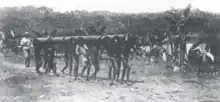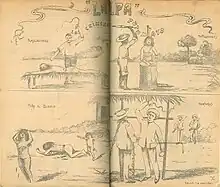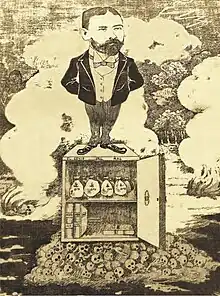Julio César Arana
Julio César Arana del Águila, (1864–1952) was a Peruvian entrepreneur and politician. A major figure in the rubber industry in the upper Amazon basin, he is probably best known in the English-speaking world through Walt Hardenburg's 1909 articles in the British magazine Truth, accusing him of practices that amounted to a terroristic reign of slavery over the natives of the region. A company of which he was the general manager, the Peruvian Amazon Company, was investigated by a commission in 1910 on which Roger Casement served. He was appointed its liquidator in September 1911.[1] He later blamed the downfall of the company on the British directors for neglecting to manage the Peruvian staff,[2] of whom he was chief. Arana was the main perpetrator of the Putumayo genocide: where his company exploited and exhausted Indigenous populations to death, in exchange for rubber.
Julio César Arana | |
|---|---|
 Julio César Arana del Águila. Estudio Courret. Lima, c. 1912 | |
| Senator of the Republic of Peru for Loreto | |
| In office July 28, 1922 – October 12, 1929 | |
| Mayor of Iquitos | |
| In office 1902–1903 | |
| Personal details | |
| Born | Julio César Arana April 12, 1864 Rioja, Peru |
| Died | October 7, 1952 (aged 87) Lima, Peru |
| Spouse |
Eleanora Zumaeta (m. 1887) |
Arana became a senator for the Department of Loreto from 1922 to 1926 and, as a result of the Salomon-Lozano Treaty, signed in Lima in 1927, Peru transferred his properties in the Putumayo to Colombia. He died at age 88, penniless, in a small house in Magdalena del Mar, near Lima.[3]
Early life
Julio César Arana was born to Martín Arana in Rioja Peru, on April 12, 1864. The family was from Cajamarca, in the north of Peru and close to the Amazonian forests to the east. Martín Arana made a career out of making, and selling straw hats in Rioja. His son, Julio joined him at age nine, and spent the next few years learning about the trade. At age 15, his father sent him to Cajamarca to learn bookkeeping and general business administration, rather than see his son go to war against Chile. After two years in Cajamarca, Julio ventured to the jungle, confident that he knew enough about business to take advantage of new opportunities. The rubber boom had just started to affect the Amazon, and was years away from its peak at this point.
Julio decided to move to the town of Yurimaguas, which was on the Huallaga River, a tributary of the Marañon River. From there, he was able to sell his father's hats through the Amazon basin. He wanted to invest into the rubber trade, believing that he could make a lot more money. However he lacked the funds to invest for a business venture. At the age of 23, he married Eleanora Zumaeta: they knew each other as children in Rioja. He was able to secure some funding out of the convenient marriage: and invited his new brother-in-law, Pablo Zumaeta to join him in business. The two opened up a trading post in Tarapoto, which was a district rich in rubber and close to Yurimaguas. The very next year, they bought a portion of a rubber forest near Yurimaguas.[4]
Arana and Zumaeta soon traveled for the Ceará region in Brazil, which had recently suffered a dust bowl and famine. They secured and hired twenty men: taking advantage of their destitute situation. These men would be the first debt peons of Arana, exploited in exchange for their services. In 1889, Arana invited another brother-in-law, Abel Alarco, to join him at Iquitos, where they could set up business in the city. Arana originally focused his business on peddling, and transportation around Iquitos, and became specifically interested in rubber forests in the Putumayo basin. Julio adopted the practices of the Colombians in the region: who made it their business to enslave and exploit the natives to extract rubber.[5]

Rubber baron

Julio Arana started multiple enterprises in collaboration with different business partners in the 1890s. Two of these notable partners include Juan B. Vega and Luis F. Morey, who established the Vega, Morey y Compania in 1890. Another company founded in the same year was Arana y Vega Ltda. This relationship help to facilitate transportation for Arana's expanding enterprise.[6] Around 1896, he entered a business partnership with Benjamin Larrañaga and his son Rafael. The Larrañaga's owned La Chorrera, a settlement on the Igaraparaná where they enslaved the native population to extract rubber. Some of the enslaved native groups used for labor in the Putumayo include: Huitoto, Andoque, Bora, and Ocaina. Sometime in 1898, Julio opened up a commercial house in Iquitos for his enterprise. His largest competitor in the city, Carlos Fitzcarrald, drowned in an accident on the Urubamba River the previous year.
Arana soon began peddling firearms, liqueur, and goods with other Colombians along the Putumayo: negotiating business with as many of them as possible. In 1900, the business partnership would turn into the Larrañaga, Arana y compañia. By 1902, Arana's enterprise accounted for 8 percent of Iquitos total rubber exports: and about 5 percent of its total imports. In this year, he became the mayor of Iquitos due to his success and reputation. By this time, most of the Colombian entrepreneurs in the region were on Arana's books. If the Colombians in the Putumayo wanted to sell rubber at all, they would have to go to Iquitos. From Iquitos, they managed the supplies they needed and negotiated credit. Arana facilitated everything for them.[7]

After the death of Benjamin Larrañaga in 1903, Arana bought out the son, Rafael's share: "taking advantage of their ignorance and stupidity to rob them scandalously."[8] Around that time, Arana changed the name to J.C. Arana y Hermanos. There was a headquarter branch in Iquitos, managed by Pablo Zumaeta: and another in Manaus directed by Lizarado Arana.[9] Zumaeta was general manager of the company: responsible for operations in the Putumayo: while Lizardo was responsible for commercial transactions in the commercial hub that was Manaus.[10] After securing La Chorrera from the Larrañaga's, he bought out Gregorio Calderón and the Calderón hermanos at El Encanto. From 1904 onwards, Arana and his company annexed Colombian rubber properties: "amounting to more than 40 settlements".[9] They carried this out through manipulation, or force. In 1904, Arana sent his brother-in-law Abel Alarco to take advantage of the economic crisis happening in Barbados. Barbados was a frequent stop along the Booth Steam Ship Co. route that took rubber to Liverpool. Over the course of 9 months somewhere around 200 men from the island became indentured to the company: initially for a period of 2 years.[9]

When the Barbadians arrived to the Putumayo region, they were used as enforcers against the natives. These men were foreigners with no connection to the people or land in the Putumayo: and stood out. It was virtually impossible for them to run away from the territory. At the end of 1904, an expedition was sent out with some of the Barbadian men to set up the plantation of Matanzas. Armando Normand accompanied them, and would later become the manager of that station. An investigation later carried out by Roger Casement determined that the Barbadians had committed horrible atrocities at the behest of their overseers. They were the perpetrators of many floggings and murders committed against the natives. The investigation determined, that when the Barbadians complained or were defiant, they "received ill-treatment and were subjected to torture, for which they do not appear to have received any compensation as British subjects."[11][12]
Arana continued his campaign against the Colombians, and by 1907 most of them had disappeared. El Dorado, La Uníon, and La Reserva were the only notable Colombian settlements in the Putumayo: they were destroyed in 1908. The American engineer Walter Ernest Hardenburg was travelling through the region, on the way to Bolivia and was captured by the company around that time. He witnessed the massacre at La Uníon and subsequent atrocities. His friend, Walter Perkins, relayed to him the atrocities he had seen at La Reserva: and the murder of David Serrano. The two eventually made it to Iquitos: where Hardenburg was approached by Miguel Galvez. Galvez was the son of Benjamin Saldaña Rocca, who was an activist in protest against Arana.[7]

Saldaña originally filed a criminal petition against 18 members of the J.C. Arana y Hermanos company: urging a judge to investigate. When he felt ignored, Saldaña founded the newspapers La Sancion on August 22, 1907: and La Felpa on August 31. The newspapers both published revelations and information that came from ex-employees of Arana. La Felpa used a political cartoon at its center to make its point. The very first issue of La Felpa had four different graphics captioned: "The Crimes of the Putumayo: FLAGELLATIONS, MUTILATIONS, TORTURES, AND TARGET PRACTICE." The last issue of Saldaña Rocca's publications came out on February 22, 1908. He was tipped off that law enforcement was on their way to escort him out of Iquitos. Saldaña managed to collect his documents and store them with the mother of his son for safe keeping. Eventually, he got word to his son Miguel Galvez to give his work to someone who would continue the crusade against Arana. The son, decided to give that work to W.E. Hardenburg, who had arrived three weeks earlier in Iquitos. The documents inspired Hardenburg to continue investigating and exposing Arana’s company.[13]

In 1910 English consul Roger Casement was sent to the Putumayo to investigate claims that Barbadians were working for Arana’s company. Previously in 1904, Casement wrote an investigative report in the Congo Free State, which exposed the Congo genocide to the world. He had no jurisdiction to investigate the natives themselves, since they were not English subjects. Through the Barbadian overseers, Casement was able to learn about the atrocities occurring in the region. Casement was able to collect multiple first hand accounts from the Barbadian employees, which were full of criminal indictments. The report compiled by Roger was released in 1911, containing accounts by perpetrators and victims of the atrocities. The report sparked outraged, and eventually led to the liquidation of the Peruvian Amazon Company. Julio César Arana and other important figures with roles in the Putumayo genocide were never persecuted.

As a testament to the popularity of Arana’s business partners in Iquitos, Pablo Zumaeta became the mayor of the city in 1912 and 1914, then between the years of 1922-1923.[14] When Victor Macedo protested against his arrest warrant in Lima: the judge who issued the order was dismissed from office. The 236 other arrest warrants issued against Arana’s employees were also dropped. Years after the scandal Julio César Arana became the senator of Loreto.

Later life
After the scandal and liquidation of the company: Arana retained a significant portion of the companies property, as well as the native work force. He was still popular enough in his home country to become a senator of Peru in 1921. That year, the Peruvian government gave Arana legal titles to his properties in the Putumayo. Julio César was one of the strongest opponents of the Salomón-Lozano Treaty, which gave Colombia the rights to the Putumayo region instead of Peru. In compensation for his loses, Julio wanted £2,000,000 from the Colombian government but they refused. The two governments did agree to respect concessions made to private individuals though.
Before the border could change, Arana, along with Miguel S. Loayza and Carlos Loayza, organized a series of forced migrations. Over the next 8 years, natives from the right bank of the Putumayo were relocated in groups of 50-100 to the Ampiyacu basin in Loreto, Peru. At least 6,719 people from the Witotos, Boras, Andoques, Ocainas, and Muinanes tribes were reloacted. Carlos Loayza stated that 50% of that group died off during the relocation: with malaria, small pox, measles, and beriberi.[15]
Years later Arana had a role in aggravating the political conflict into the Colombia-Peru war. He was apart of the group of aristocrats who founded the ‘Patriotic Junta of Loreto.’ Julio’s daughter was a part of the Junta, as well as his son son, Luis A. Arana. The Arana’s provided firearms for a makeshift force, which captured the port of Leticia on September 1, 1932. A cease-fire was agreed upon four months later, which reestablished the status quo of the treaty. [16]
Arana sold his Colombian land concessions in 1939 during the Great Depression. Either from making a ‘bad mistake’ or being swindled, Julio seemingly came out of the situation penniless. A large amount of the money meant for Arana from this deal was never paid out during his lifetime.
For the last years of his life, Julio lived at Magdalena del Mar, a suburb of Lima. Julio César Arana died at 88 years old in September 1952, with ‘his passing virtually unnoticed by the public.’ The grave of Arana is made from cement: and located in a common cemetery used for the poor.[17] In 1964 the Colombian government paid the remaining sum of 160,000 dollars from the Putumayo estate sale to Víctor Israel, who was an ally and long term business partner of Arana. [18]

See also
References
- "No. 28539". The London Gazette. 6 October 1911. p. 7306.
- "The Peruvian Amazon Company: No Return to Shareholders", The Advertiser (Adelaide, SA : 1889 - 1931), Mar 20 1914. retr 2012 9 24 from http://trove.nla.gov.au
- Charles C. Mann (2011), 1493: Uncovering the New World Columbus Created, Random House Digital, pp. 258–260, ISBN 978-0-307-59672-7
- Goodman 2009, pp. 36–37.
- Goodman 2009.
- Barclay, Frederica; Santos-Granero, Fernando. La frontera domesticada historia económica y social de Loreto, 1850-2000. pp. 98–99.
- Goodman 2009, pp. 37–39.
- Hardenburg 1912, p. 200.
- Goodman 2009, p. 38.
- Goodman 2009, p. 41.
- Hardenburg 1912, p. 40.
- MacQueen, Peter (September 1913). "A Criminals Life Story The Career of Armando Normand by Peter Macqueen". THE NATIONAL MAGAZINE, AN ILLUSTRATED MONTHLY volume XXXVIII: April to September, 1913. 38 (38): 943. Retrieved 17 July 2023.
- Goodman 2009, pp. 44–47.
- Almanaque 2001, p. 72.
- Víctor San Román, Jesús (January 1, 1994). Perfiles históricos de la amazonía peruana. Peru / Colombia: Instituto de Investigaciones de la Amazonía Peruana. pp. 191–192. ISBN 8489295808. Retrieved 18 July 2023.
- Goodman 2009, pp. 259–260.
- Goodman 2009, pp. 260–261.
- Zárate Botía, Carlos (2019). Amazonia 1900-1940: el conflicto la guerra y la invencion de la frontera (PDF). Universidad Nacional de Colombia. p. 34.
Bibliography
- Hardenburg, Walter (1912). The Putumayo, the Devil's Paradise; Travels in the Peruvian Amazon Region and an Account of the Atrocities Committed Upon the Indians Therein. Putumayo: London: Fischer Unwin. ISBN 1372293019. Retrieved 16 July 2023.
- Goodman, Jordan (2009). The Devil and Mr. Casement: One Man's Battle for Human Rights in South America's Heart of Darkness (First American Edition 2010 ed.). Putumayo: Farrar, Straus and Giroux. ISBN 0374138400. Retrieved 17 July 2023.
- Almanaque de Loreto 2001-2002. Instituto Nacional de Estadística e Informática, Oficina Departamental de Estadística e Informática Loreto. 2001.
External link
![]() Media related to Julio César Arana at Wikimedia Commons
Media related to Julio César Arana at Wikimedia Commons